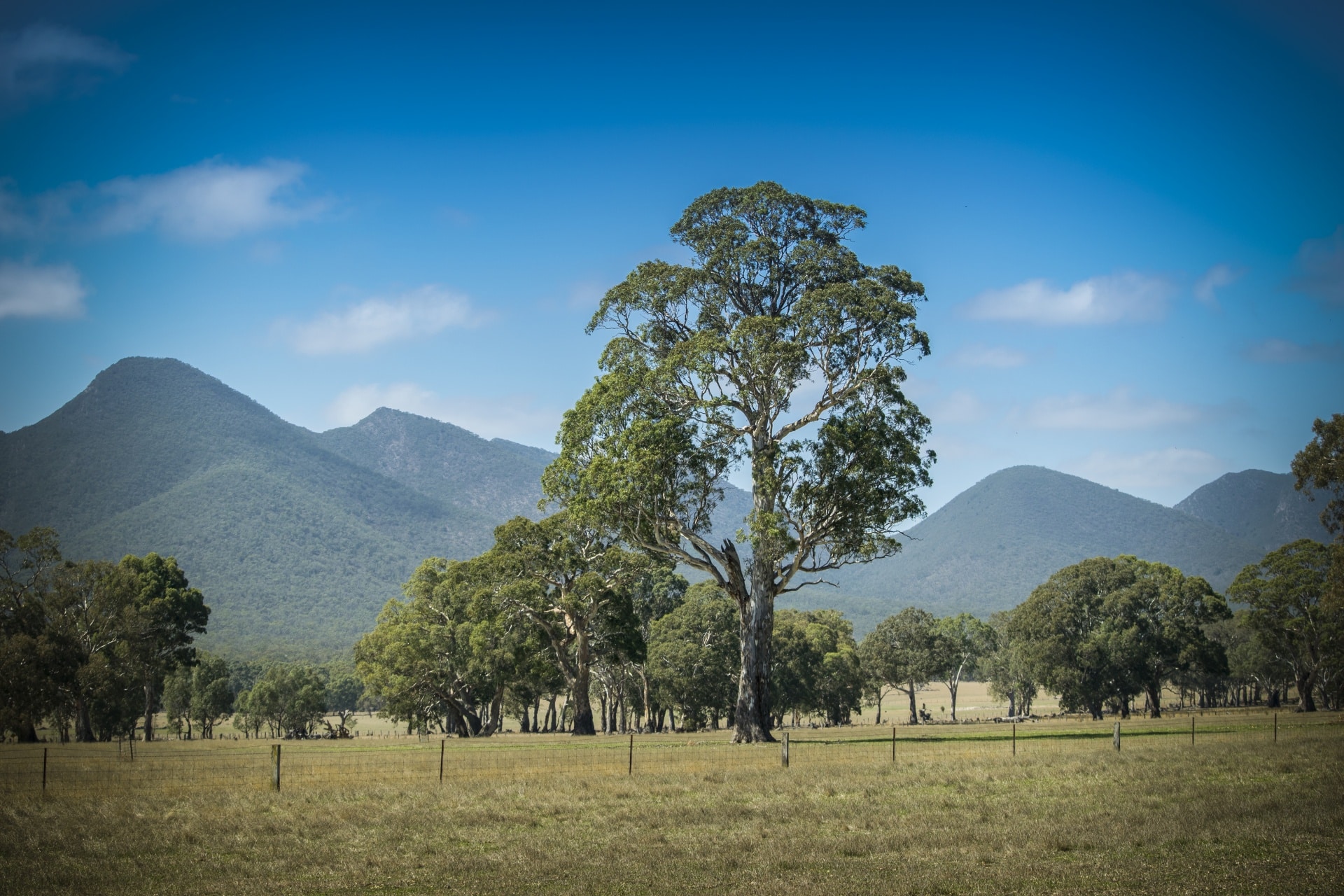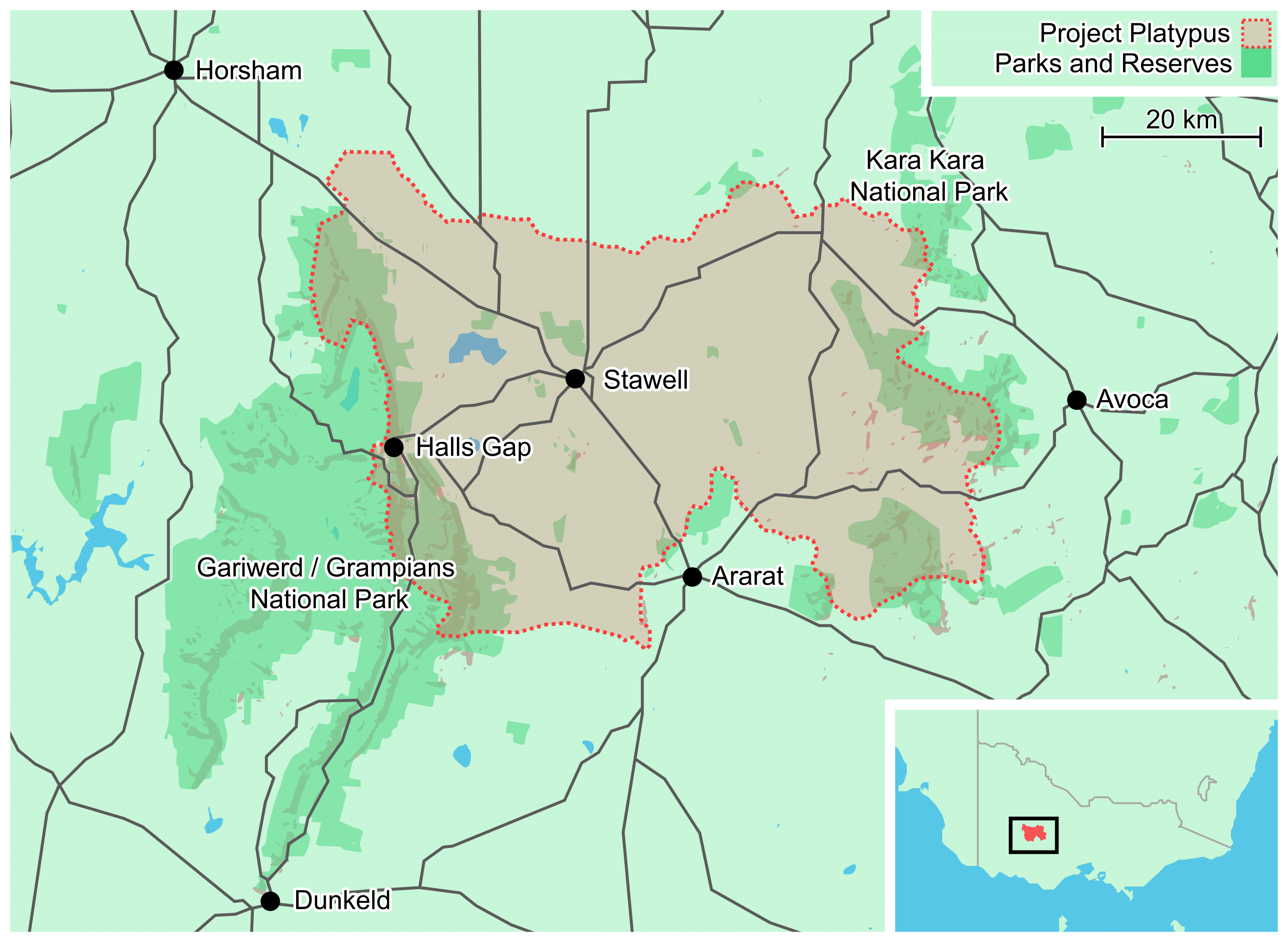Project snapshot:
Project Platypus: Holistic community land management in Gariwerd / Grampians surrounds
Showcasing the Project Platypus’ holistic land community management program:
The Upper Wimmera Catchment in western Victoria is an ecologically rich region stretching from the headwaters of Barringgi Gadyin / the Wimmera River at Mount Cole, to the Mount William Creek junction near the northern end of Gariwerd / the Grampians Ranges. Bordered to the west by the Gariwerd / the Grampians Ranges and to the east by the Pyrenees Ranges, this landscape spans over 3,000 square kilometres and supports a mosaic of farming properties, conservation reserves, forested public land, and rural townships. The region holds both cultural and ecological significance. Traditional Owner groups include the Jardwadjali, Djab Warrung, Djadja Wurrung, Wotjobaluk and Wadawurrung Peoples, with Registered Aboriginal Parties such as the Barengi Gadjin Land Council and Dja Dja Wurrung Clans Aboriginal Corporation recognised as custodians of Country. The Upper Wimmera Catchment is home to a range of threatened species including the Southern Brown Bandicoot, Swift Parrot, Bush Stone-curlew, and the platypus.
Project Platypus, named after the now locally rare platypus, is a community-driven initiative dedicated to restoring the health and productivity of the Upper Wimmera Catchment. The platypus represents what has been lost from the local environment, and what could return with collective effort. Since 1995, using a holistic approach to conservation, Project Platypus has worked closely with 12 Landcare groups and an extensive network of landholders, agencies, and community organisations to deliver landscape-scale habitat restoration and invasive species control, planting more than one million trees and improving 1,500 hectares of habitat. They have long understood that the health of the landscape and its communities depends upon strong collaboration, strategic planning, and consistent action. In recent years, the group has turned its attention more directly to the threat posed by invasive plants and animals, particularly in the area surrounding Gariwerd / the Grampians National Park where agriculture, lifestyle blocks, and national parks meet.
With funding from Victorian Government’s Partnerships Against Pests program, Project Platypus has launched a four-year initiative to combat established invasive species across the Gariwerd / Grampians landscape. Known as “Guarding Gariwerd”, this program unites Landcare networks, Traditional Owners, public agencies, and private landholders in a coordinated effort to reduce the impacts of feral animals and priority weeds. The initiative includes neighbouring networks such as Horsham District Landcare Network and Yarrilinks Landcare Network, with strategic support from organisations including Parks Victoria, the Wimmera Catchment Management Authority, Trust for Nature, local governments, and the National Feral Cat and Fox Management Coordination Program (NFCFMC Program) and National Feral Rabbit Management Coordinator (NFRMC).

Project Platypus’ work spans the various land tenures of the Upper Wimmera Catchment, between Gariwerd and the Pyrenees. Photo: Sandy Frew.
Gariwerd / Grampians National Park is one of Victoria’s most iconic natural reserves, containing a third of the state’s plant species and offering refuge to a range of rare and threatened fauna. However, the park is surrounded by highly productive farmland, residential blocks, and public access routes, leaving it vulnerable to invasion from foxes, cats, rabbits, deer, and a suite of aggressive weed species. In turn, many of these pests and weeds are also impacting the local farmers. The Guarding Gariwerd project aims to create an informed, capable, and connected community of land managers and groups who can work across boundaries to reduce pressure on this ecologically important, culturally significant, and productive landscape.
Project Platypus’s Guarding Gariwerd initiative is designed to complement the work happening inside Gariwerd / Grampians National Park itself, particularly through Parks Victoria’s long-running Grampians Ark program. Operating for nearly three decades, Grampians Ark focuses on reducing fox populations to protect threatened species like the Brush-tailed Rock-wallaby. The program spans more than 226,000 hectares across the Gariwerd / Grampians National Park, Black Range State Park, Grampians State Forest, and adjoining private land, and is delivered in partnership with local Landcare groups through the Weeds and Pests on Public Land program. Following the major bushfires of early and late 2024, this work has become even more critical, with predators taking advantage of fire-cleared vegetation to hunt more effectively. In response, Parks Victoria has expanded its baiting and padded foot-hold trapping work across the park and is rolling out new motion camera grids over 100 km² to monitor feral cat and fox activity and guide control efforts.
In high-priority areas, such as the rocky escarpments of Mura Mura where rock-wallabies are supplemented with food post-fire, targeted shooting and canid pest ejectors (CPEs) are helping to reduce predator pressure. Normally shooting is a less effective tool for broadscale fox management, however in the open landscapes of the burn area, foxes have been easily spotted and targeted. An innovative bushfire recovery measure being trialled is the deployment of over 160 biodegradable ReHabitat pods – cone-shaped artificial refuges offering shelter to small native animals in the fire scorched landscape. Motion cameras have already captured images of foxes and cats inspecting the pods, reinforcing the need for ongoing control alongside habitat recovery. While forested and riparian areas of the park are showing strong epicormic regrowth, fire-sensitive ecosystems like the sandy heathlands of Victoria Valley are recovering more slowly. Parks Victoria’s small but dedicated team continues to manage invasive species across both burnt and unburnt areas, delivering essential ecological stability in a landscape increasingly shaped by a changing climate.

A map of Project Platypus’ area of operation. Image: CISS, NFCFMC Program.
Back in the buffer zone around the park, the heart of the Guarding Gariwerd project lies in its seasonal workshops and field days designed to upskill landholders and strengthen relationships between community members, Landcare groups and agency staff. Priority-setting sessions were first held with Landcare groups to identify their top local weed and pest species, and to assess knowledge gaps and resource needs. From these, local “top ten” plant and pest lists were created, providing a foundation for practical education sessions tailored to community priorities. Three of the top pests identified were foxes, rabbits and feral cats, which is where the National Coordinators come in.
The National Feral Cat and Fox Management Coordination Program provided letters of support and in-kind commitment to grant applications to help fund the initiative. This commitment included attending and presenting at a number of workshops and providing materials and input where needed. The workshops were particularly hands-on, and attendees were educated on the best practice approach to a number of important pest control techniques. Gillian Basnett, the NFCFMC, spoke about the approved methods available for managing foxes and cats in Victoria and how best to use them. She introduced canid pest ejectors (CPEs), a stationary, immovable toxin-delivery device triggered by a fox (or wild dog) pulling on a lure head. Attendees were given a demo with an non-toxic capsule and were instructed on how to safely bait, prime, and deploy the devices. Gillian also presented on the impacts of feral cats in both environmental and agricultural contexts, highlighting the role of toxoplasmosis in livestock loss and its emerging links to human health concerns. This session helped bridge a critical knowledge gap in the region, where landholders are increasingly aware of feral cats but uncertain about how they can be managed legally and effectively.
At the same workshop the process of effective rabbit control was demonstrated including baiting and fumigating and ripping rabbit warrens. These demonstrations were carried out with help from Project Platypus’ team and, at the latest workshop, the National Feral Rabbit Management Coordinator (NFRMC) and Victorian Rabbit Action Network (VRAN). The fumigation demonstration included the use of a smoker to identify all tunnel entrances before inserting fumigant tablets, and covered the importance of sealing all exits to ensure fumigants and rabbits don’t escape. A highlight of the sessions was a warren ripping demonstration led by a Landcare member using a tractor and some age-old techniques to ensure complete collapse of burrows. Local landholders shared tips on how to achieve good soil compaction post-ripping, which is essential to prevent reinvasion. Project Platypus, the NFRMC and VRAN presented on integrated control strategies in rabbit management, discussing when to use various tools, from baiting to warren ripping and fumigation. A consistent message throughout the day was the importance of choosing the right control tools for the situation, timing activities for maximum effect, and working collaboratively to reduce reinvasion pressure.
Lachlan McIntyre of Project Platypus and Gillian Basnett, the National Feral Cat and Fox Management Coordinator, give a Canid Pest Ejector demonstration at one of Project Platypus’ workshops. Video: Project Platypus.
This integrated approach is the cornerstone of Project Platypus’s invasive species work. Rather than tackling pests in isolation, the project considers how different species interact across landscapes – how, for instance, high rabbit numbers can support elevated fox and cat populations by boosting food availability. By working strategically to suppress multiple pest species across public and private land, the project aims to ease the burden on native wildlife and agricultural systems alike. This holistic approach enhances the work undertaken by Project Platypus and its audience.
With the Guarding Gariwerd program now in its second year, Project Platypus is already strengthening ties between neighbours, building capacity among landholders, and fostering shared responsibility for protecting the Grampians region. As more community members engage with the program and agency and other partners deepen their collaboration, the initiative is laying the groundwork for long-term, landscape-scale pest and weed management. Invasive species pose one of the greatest threats to Australia’s biodiversity and agriculture. Project Platypus is helping lead the charge in tackling this challenge – restoring habitat, reconnecting fragmented landscapes, and creating healthier, more resilient ecosystems for people, wildlife and livestock alike.
Information in this section was obtained from Project Platypus, Parks Victoria, and the National Feral Cat and Fox Management Coordination Program [1, 2, 3, 4, 5, 6].
This project snapshot initially appeared in the May 2025 issue of the National Feral Cat and Fox Management Coordination Program Newsletter. To subscribe to the newsletter, click here or fill out the form at the bottom of the page.
Banner photo: Michael Robinson.
Other Resources
Click here to find out more about FeralScan a free community-designed website and smartphone app that allows you to record observations and evidence of introduced pest animals (such as foxes and feral cats), the damage they cause (including predation of native wildlife or lambs), and control actions in your local area (such as baiting, trapping and shooting).
The PestSmart Toolkits provide further information about how to plan, manage and improve your feral cat or fox management program.
The CISS Glovebox Guides, Planning Guides and Field Guides are useful pdf or printed booklets for managing pest animals like feral cats and foxes, developing a simple feral cat or fox management plan or undertaking a best practice baiting program.
